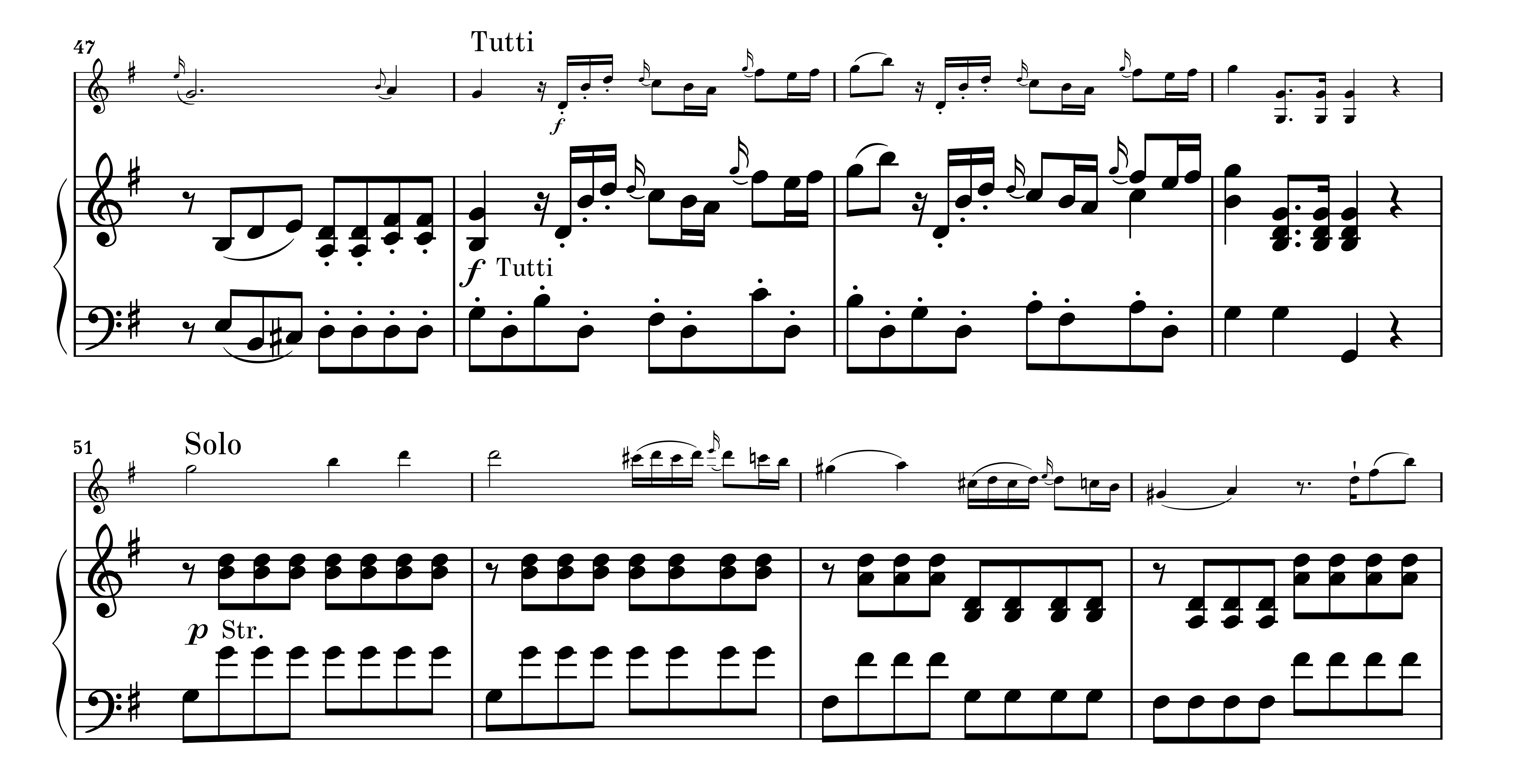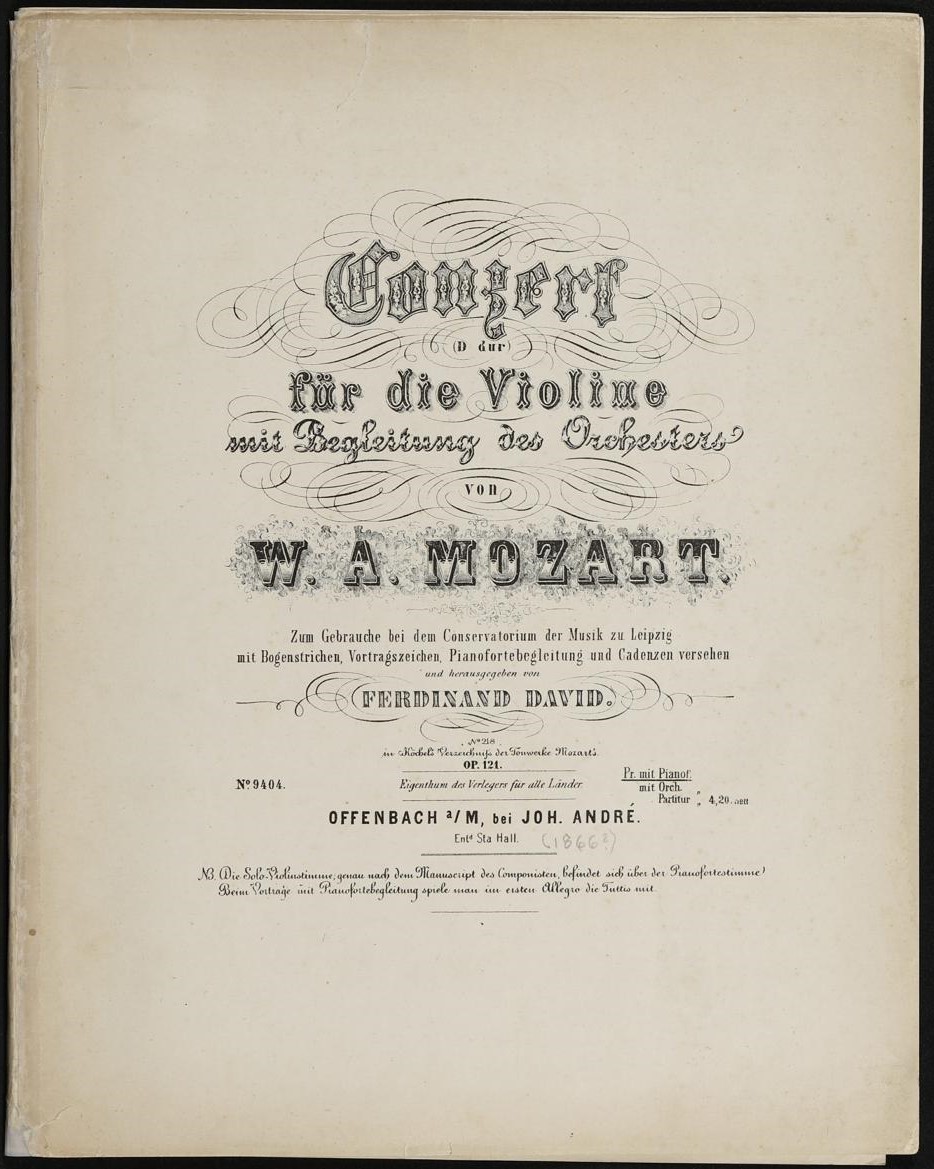As Urtext editors, we could sometimes despair: we’re offering the music world a reliable music text, but those for whom all our work is devoted go on ignoring the new findings in their playing and teaching.
You’d like an example? I recently heard a young, very talented Korean violinist play Mozart’s D-major Concerto, K. 218 (HN 680). Apart from the fact that he unfortunately dispensed with the ‘common sense’ standard, at least in historically informed performance practice, of playing the tutti passages and conducting the orchestra as primarius, we heard in detail all those little note errors and subjective editorial additions ultimately going back to Ferdinand David’s first edition of 1865.
Let’s take the solo violin’s entry in measure 42: our violinist is still not the only one who plays something like this – for the old errors persist:

Mozart, Violin Concerto D-major, K. 218, ‘SOLO’
(mm. 42ff.), first edition, Breitkopf & Härtel, 1865,
ed. by Ferdinand David
Short appoggiatura and forte – He ultimately played the passage as we know it from David Oistrakh (though he couldn’t match Oistrakh’s tone and verve):
A close reading of (my) Urtext edition will reveal that this is not a short but a long appoggiatura to the first note, to be played on the beat. The appropriate dynamics would have to be negotiated. In Mozart’s autograph, the passage looks like this:

Mozart, Violin Concerto D-major, K. 218, ‘Solo’ (mm. 42 ff.), autograph in Krakau, Biblioteka Jagiellońska
Playing – correctly – a long appoggiatura, the opening in the high register seems much gentler and not quite so ‘here I come’ – trumpeting à la Oistrakh. And then, notice that the solo violin has no dynamics indication: the two accompanying tutti violins are piano! Of course: the opening passage (including the first tutti) is rather march-like thanks to the dotting. It is easy to imagine with timpani and trumpets. But it’s a solo violin in a fairly high register, delicately accompanied in piano. I mean: this is not a march, but a kind of ‘intoning’ or ‘voicing’ of a banal D-major triad, with a long upbeat, so to speak, on the single note e3. Apparently, music that is ‘less important’ than everything to follow. So, there’s no need to show off as a soloist here. Dear violinists: try it a little more moderately, perhaps in mezzoforte and played more casually. At least that’s what I read from Mozart’s autograph.
Incidentally, we see a Mozart deletion in the autograph just before the solo violin enters. When interpreting the concerto, it can only help if we ask what could have prompted Mozart subsequently to delete this unaccompanied D-major triadic upbeat (possibly only after completing the manuscript). As soon as we speculate about what might have been musically improved by this deletion, we understand a bit more about the D-major concerto – and about Mozart in general. (Especially because the work’s autograph is freely and easily accessible online, there is really no excuse not to study it in preparation for interpreting the work.)
Gabriel Banat gives an interesting reference in his insightful preface to the facsimile edition of all the violin concertos (The Mozart Violin Concerti: A Facsimile Edition of the Autographs. Mineola, New York, 2015). Mozart had already written such a triadic upbeat before (the second) entry of the solo violin, a few weeks prior to the D-major Concerto, that is, in the first movement of the G-major Concerto, K. 216 (= second solo section, m. 51):

Mozart, Violin Concerto G-major, K. 216, ‘Solo’ (mm. 51 ff.), Urtext edition, G. Henle, 2002, ed. by Wolf-Dieter Seiffert (HN 688)
Banat speculates that possibly Mozart was embarrassed by this ‘repetition’ of his idea, which is why he deleted it. On the other hand, the violin also plays an ascending triad at its entry in the following concerto, in A-major, K. 219 (m. 40). All three violin entrances are (or in the case of K. 218: were) interestingly related, but not like identical twins. Perhaps you, dear reader, have another idea as to why Mozart deleted this not actually wrong triadic measure in the D-major concerto?


How can you call it an “Urtext” edition when you reduced the entire orchestration to piano? This is effectively an arrangement – the “urtext” is at most of the violin part only. Granted, this is a comment about that violin part, but there is an entire orchestra behind it, too.
Dear Robert, thank you for your question. This is common practise. We do document the, indeed, different parts of such sort of Urtext edition on every title page: there you find (1) the name of the composer (Mozart), (2) the name of the piano-reduction arranger (Siegfried Petrenz), and (3) the name of the author of the printed fingerings, bowings, and cadenzas/lead-ins (Kurt Guntner). Hope this explains.